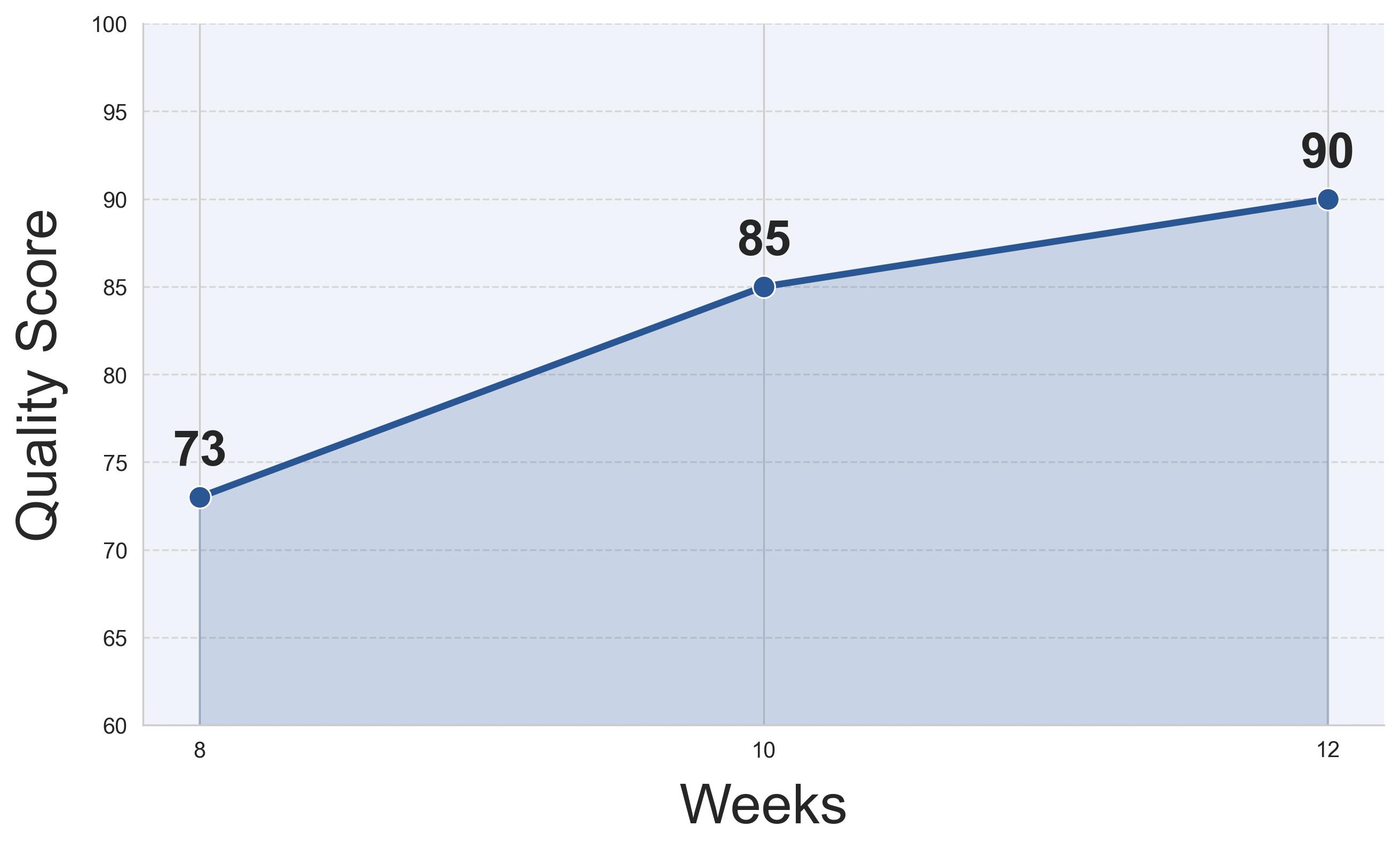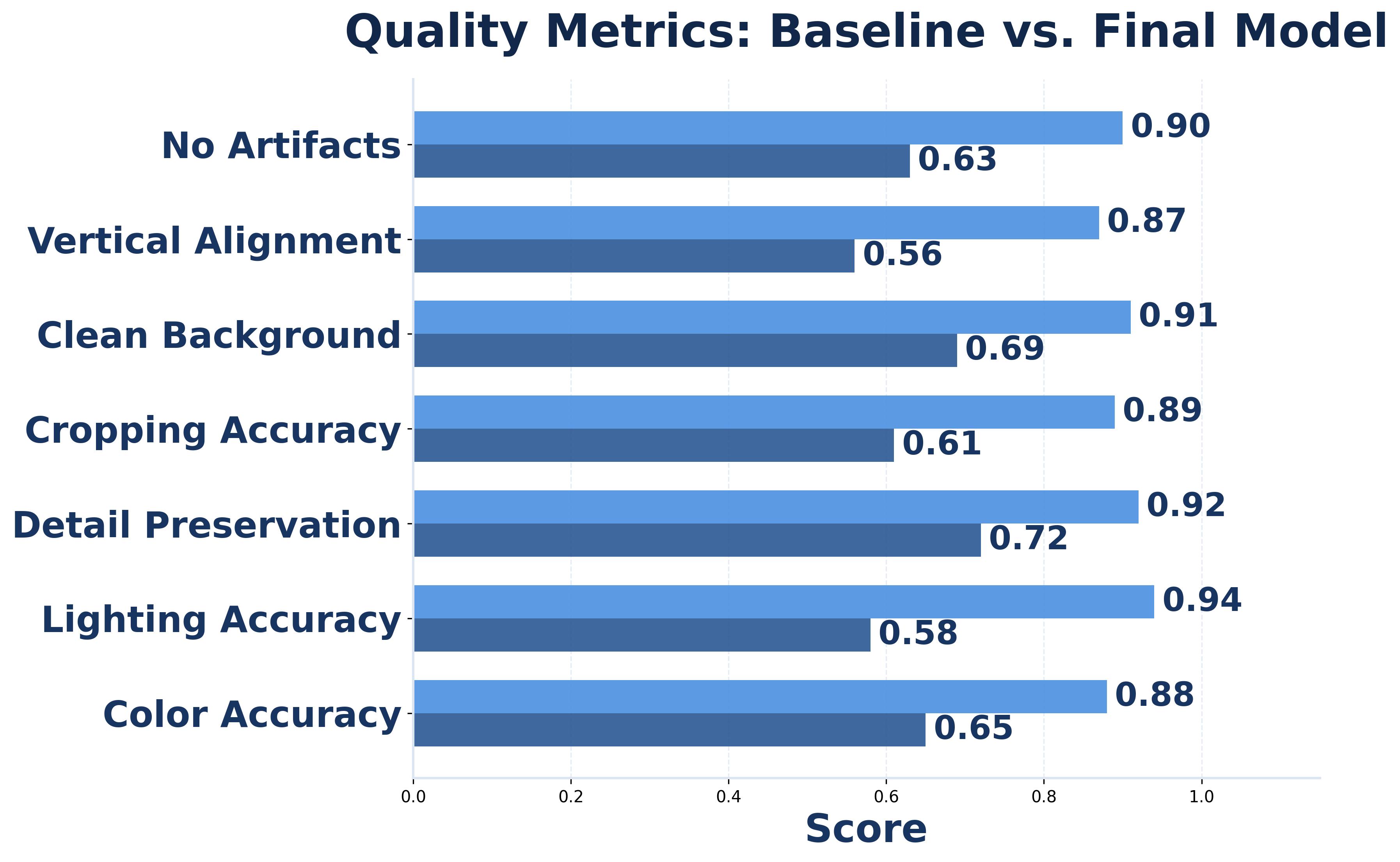Case Study - AI-Powered Photo Retouching at Scale
How we developed an AI image enhancement system that matches professional retouching quality while processing thousands of product photos daily.
- Client
- Confidential
- Year
- Service
- AI Strategy & Roadmap, ML Model Development, Integration & Deployment

Case Study - AI-Powered Photo Retouching at Scale
Developing an AI-powered pipeline to automate professional-grade photo retouching, ensuring consistently high quality at scale while dramatically reducing costs.
Overview
In online retail, high-quality product photography directly impacts conversion rates and customer trust. Our client, a major e-commerce marketplace, had built their competitive edge by becoming a marketplace of luxury goods with a premium user experience, which includes outstanding product imagery. However, their manual retouching process had become a significant bottleneck, with a team of professional editors struggling to keep pace with thousands of new products arriving daily.
We partnered with them to build an unprecedented solution: an AI system that could match professional human retouching quality across diverse product categories while handling their massive scale requirements—all without compromising the visual standards that differentiated their brand.
Services Provided
- AI Roadmap
- Machine Learning
- Computer Vision
- Cloud Integration (GCP)
- Production Deployment
Project Overview
The Challenge
Creating an AI system that could match professional human retouching presented several unique hurdles—from achieving the quality standards of skilled human editors to scaling across thousands of diverse product categories.
Matching professional retouchers' eye for subtle details like lighting, alignment, color accuracy and a perfectly clean background
Handling diverse product categories, from clothing and shoes to accessories
Processing over 10,000 high-resolution images daily
No labelled data on how to perform each step, just the before and after images.
Integrating seamlessly with existing workflows
Our Approach
We broke this complex challenge into three strategic phases, building confidence at each step through a methodical, iterative approach focused on continuous quality improvement.
Proof of concept with a single product category
Incremental expansion to additional product types
Full-scale cloud deployment with human-in-the-loop fallback
Each phase built upon the success of the previous one, minimizing risk while maximizing results.
The Impact
Our AI retouching solution delivered transformative business impact across multiple dimensions, combining substantial cost savings with significant quality and workflow improvements.
Supply covered by automation
AI edits indistinguishable from human work, based on blind tests
Reduction in image publishing time
Savings per item
Project Walkthrough
Phase 1: Proof of Concept
We started by tackling a single product category where we could validate our approach quickly. By focusing on a small clothing category with consistent retouching patterns, we could demonstrate value in no time, while managing risk.
- Built a dataset of 30,000 before/after image pairs that captured professional editing patterns
- Implemented an image registration algorithm to extract the geometric transformations between the images
- Train multiple Deep Learning models to learn each required retouching step
- Created quantitative quality metrics that aligned with human perception
- Deployed a pipeline of models to GCP, and integrating it with the creader systems
- Blind-tested our results with the client's professional editing team
After a few iterations, our first breakthrough came when the editing team couldn't consistently identify which images were retouched by humans versus our AI system—the ultimate validation of our quality-first approach.

Model quality score progression during initial development phase
Phase 2: Incremental Expansion
With the core technology validated, we methodically expanded our approach to additional product categories, each with unique visual characteristics and retouching requirements.
Category Analysis
We conducted in-depth analysis of retouching patterns across different product types, identifying common techniques and category-specific requirements.
Model Adaptation
Our team developed specialized ML models for clothing, shoes, and accessories, each optimized for the unique visual characteristics of these categories.
Targeted Deployment
We prioritized the low hanging fruits: categories with highest volume and simpler retouching needs, generating immediate ROI while building confidence in the system.
Continuous Learning
By implementing a robust feedback loop, we systematically incorporated professional editor feedback to retrain our models and refine performance.
By focusing on incremental wins, we built momentum and stakeholder trust while continuously improving our models with real-world feedback from professional editors.

Example of production-quality AI retouching on diverse products
Phase 3: Full-Scale Deployment
Our full production system combined several technical innovations to achieve both the quality and scale requirements of the client's operation.
Custom CNN Architecture
Built on ResNet backbone with domain-specific enhancements for product photography
Conditional GANs
For complex generative retouching tasks requiring more sophisticated transformations (e.g. textures)
Classical Image Processing
For predictable, explainable adjustments to color balance, exposure, and sharpness
Google Cloud Platform
Optimized for cost-efficient batch processing of thousands of images daily
One key innovation was our "quality-aware" processing pipeline that could identify challenging images and route them for human review. This intelligent workflow, relying on a combination of ML models and classical image processing, combined the efficiency of automation with the discernment of human expertise.
AI Photo Retouching Pipeline
Our end-to-end AI pipeline transforms raw product photos into professionally retouched images at scale
Image Loading
Input stage
Loading high-resolution product photos into the pipeline
Color Correction
Color Processing
Image processing algorithm for color balancing and white point adjustment
Lighting Correction
Light Enhancement
Optimizing lighting, shadows, and highlights
Background Removal
Segmentation
CNN-based segmentation to isolate products
Vertical Alignment
Positioning
Ensuring consistent product positioning
Cropping
Frame Optimization
Automatic cropping for optimal product display
Detailing
Fine Enhancement
Advanced texture and detail enhancement with generative models
Image Evaluation
Quality Assessment
Rule and ML-based quality checking for human review decisioning
Image Publication
Final Output
Delivery of optimized images to publishing platforms
The quality-aware processing pipeline intelligently routes images between AI and human editors, ensuring that every product photo meets or exceeds quality standards while optimizing for speed and efficiency
Technical Deep Dive
Core Innovations
For those interested in the technical aspects, our solution incorporated several innovations that allowed us to achieve both the quality and scale requirements:
Multi-stage enhancement pipeline
Rather than using a single model, we built specialized components for different aspects (background, alignment, color, detail enhancement) that worked together in a coordinated pipeline.
Human-in-the-loop feedback system
Our models continuously improved by incorporating professional feedback on edge cases, creating a virtuous cycle of quality improvement.
Category-specific fine-tuning
We discovered that fine-tuning models for specific product categories (e.g., clothing vs. shoes) significantly improved quality by incorporating domain-specific knowledge.
Perceptual loss functions
We moved beyond pixel-level metrics to custom functions based on color science and human eye perception to better captured human aesthetic judgments, focusing on the aspects that truly matter for our users.
The most challenging aspect was handling complex reflective surfaces like jewelry and glassware. Despite solving some of this by combining traditional image processing with generative models, we still rely on human retouchers for a small, very challenging part of the supply, which we can automatically identify consistently.

Our perceptual quality assessment framework aligned AI performance with human visual judgment
Tech Stack Highlights
Key Insights & Learnings
Quality assurance is non-negotiable
We built comprehensive quality metrics early, giving stakeholders confidence in the solution. This upfront investment in quality evaluation paid dividends throughout the project.
Start narrow, then expand
By proving the concept in one category before expanding, we reduced risk and built stakeholder trust. This incremental approach allowed us to learn and adapt before scaling.
Human-AI collaboration beats replacement
The most successful deployment was one where AI handled routine cases while humans tackled the creative edge cases. This complementary approach delivered the best of both worlds.
Technical and organizational alignment matters
Our success came from understanding not just the technical problem but the organizational workflows around it. Technology that doesn't integrate with existing processes rarely succeeds.
Looking Forward
Since initial deployment, the system has continued to evolve. Recent improvements include:
Moving from batch-processing all items daily, to a streaming solution where items are processing in real time
Expansion to generating new content based the real images, like models wearing the clothing items
This project stands as a perfect example of how thoughtfully applied AI can transform a labor-intensive creative process without sacrificing quality—delivering both massive cost savings and new creative possibilities.